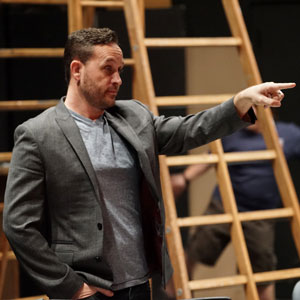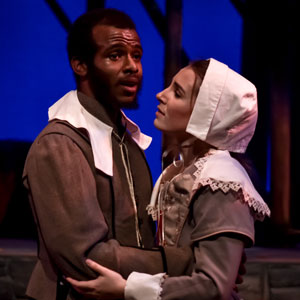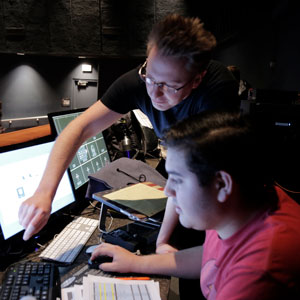"1940s Radio Hour" Brings Laughs and Nostalgia
— Fullerton College Hornet - Ryan Cambell - Monday, December 9th, 1996Fullerton College's Theater Department production of "1940s Radio Hour;''' with its comedic singing, dancing and drama, entertained its audience, while successfully providing a strong feeling of nostalgia.
The play is about a group of "B" radio players putting on a variety production called the "Mutual Manhattan Variety Cavalcade," in December of 1942, which included performances of some of the popular so:b8s from that era as well as their version of "A Christmas Carol."
It starts with Pops Bailey, the studio janitor, sweeping the floor, waiting for the cast and crew to come with all of the lights in the theater still on; This was to give the audience a sense of what the studio and stage a like before everyone takes their place to begin the show, but unfortunately, the lights still being on caused a lot of the audience members to think that play hadn't started; which led to a lot of people talking and taking their time to find their seats which was distracting for people who did know that the play had actually begun
As more of the players begin to arrive, tensions start to rise as Lou, the high-strung director, yells at crew people to get everything together and things get chaotic.
This scene was pretty effective in showing how hectic things are as all of the players got into their little, separate squabbles; making ·every little event happening on the stage amusing. Different audience members would lauhh at different episodes happening simultaneously.
Providing a good contrast to the director, Lou, played by Matthew D'Amico, was Jeff Hatch who played star-crooner, Johnny Cantone, who didn't seem as interested in taking his place as he was in finding a drink and hitting on all of the women of the cast.
Early character development was one of this play's strengths. In addition to Johnny and Lou, there was Connie and B. J., the two young lovebirds who constantly bicker throughout the night because Johnny keeps hitting on Connie; Geneva, the lounge singer whose sassiness is apparent right away when she makes a snide comment about Lou's balding hair; as well Wally, the delivery boy who desperately wants to join the group, and is caught mimicking Johnny in the background, during one of his solos.
The first few musical numbers started off a bit awkward and off key; probably due to a lack of experience in performing this style of music.
But as the play progressed, the songs started to pick up a little and by the end, they were right on the mark, most notably, "Five O'clock Whistle" and the closing number, which featured the entire cast.
What really gave a boost to the nostalgic feeling of the play were the commercials, which were consistently amusing all through out the night; especially the jingles· for Pepsi-Cola and Chiquita Bananas.
But the commercial for mud pies outshines them all, as one of the singers, Ginger describes a mud pie an in over-zealous, sensual manner which nearly sends all of the men of the cast reeling; which rovided the audience with one of the most humorous moments of the night.
Amid all of the comedy, the FC cast were able to recreate the serious side of the play when Bill Baker, one of the musicians, announces that he is doing his last show with the group before going off to fight in World War Two as a fighter pilot.
Before doing his final solo number, Bill gives a small, inspirational speech about ending the war .before the year is over, which adds an even sadder element for the audience who knew how much longer the war actually dragged on.
One of the highlights of the evening was when B.J., played by Joseph Saenz, has to sing Geneva's part in a song after she storms off of the set after fighting with Lou. This scene wasn't only funny, but it sounded really good as well, as Saenz put on a good vocal performance.
The set was authentic-looking with pictures of stars from that era on the walls behind the stage, the big, oval-shaped '40s style microphones, as well the "applause" signs and a sound room for the musicians.
However, the sound room was also one of the main drawbacks of the set because not everyone in the audience could see what was going on in it, namely when Bill gives his last solo performance.
Overall, though, the play did entertain and most of the musical numbers were catchy and the cast did provide a pretty good character development. This production of "1940's Radio Hour" was a fun introduction to that period of time in this country and its different personalities.








